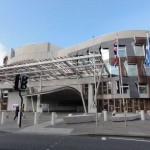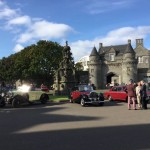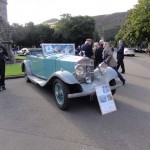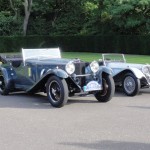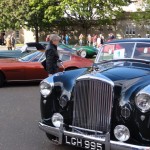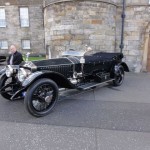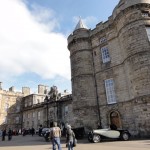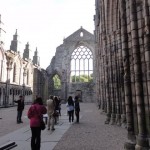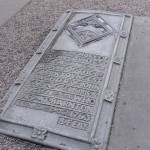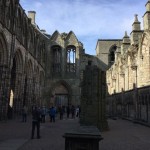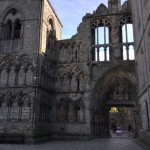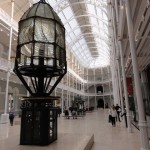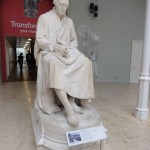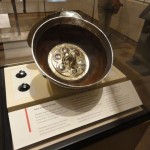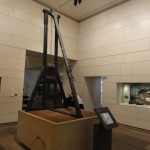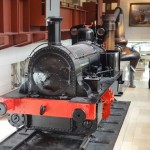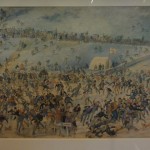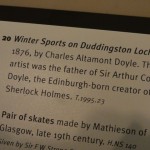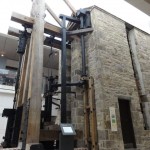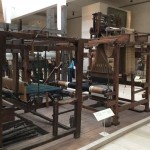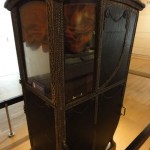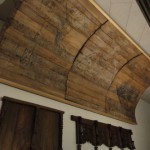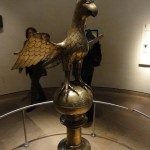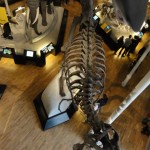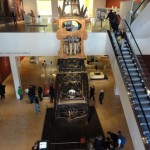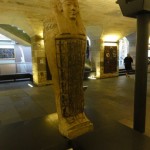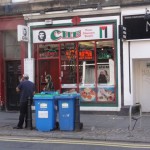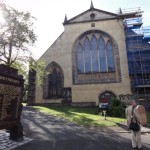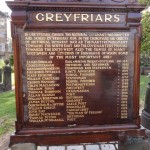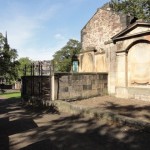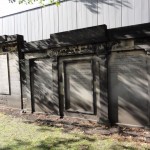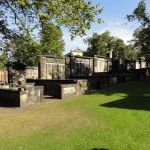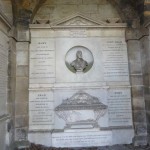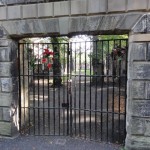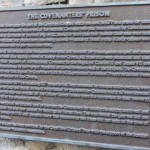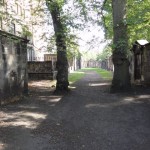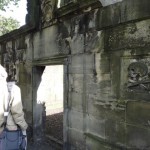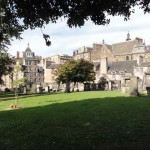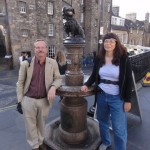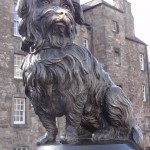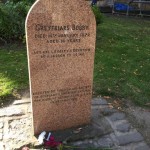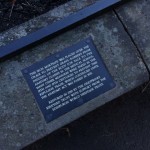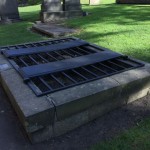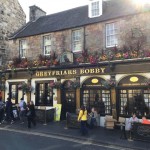Day 3: Museum of Scotland / Greyfriars Kirk
NOTE: It may seem as if I’ve given up on posting about our now not so recent trip to Scotland and Wales, and I have to admit I’ve been side-tracked by one of my brilliant ideas. I’m writing Narrowboating for Beginners, a how-to guide for Americans about to take their first canal vacation in the UK. I’m trying to get it finished and published before the end of the year, so that people contemplating a trip next summer or fall will be able to buy it in advance of their trip.
The third day of our vacation would be our last in Edinburgh so there was some urgency in our sightseeing. Our first stop was The Palace of Holyroodhouse, which is at the eastern end of the Royal Mile and very close to our hotel. It was an easy walk to the palace, except for the fact that we had to go around the very modern Scottish Parliament. By one of the many coincidences that graced our trip, we got to see many antique cars at the Concours of Elegance car rally. I had a lot of time to photograph these cars because Jim had accidentally left his travel bag at the Starbucks on the way to the palace.
The photographs also made up for the fact that I couldn’t take pictures inside the palace, ostensibly for security reasons because the palace is still a royal residence for one week out of the year, when the queen stops by on her visit to Balmoral. It also doesn’t hurt guidebook sales, although I won’t begrudge that because it meant I could relax and read all the labels instead of frantically taking pictures of everything.
The progress through the palace is familiar to anyone who’s visited other palaces: the impressive quadrangle with its layer cake of doric, ionic and corinthian columns; the grand staircase; the royal dining room; the throne room; the long gallery with the paintings of all the Scottish kings; and the various royal bedrooms and the king’s presence chamber. The highlight, of course, is the bedchamber, outer chamber and supper room of Mary, Queen of Scots, because that’s where the murder of her Italian secretary, David Rizzio, played out. Mary, of course, was the cousin of Queen Elizabeth I and was later executed by Elizabeth when Mary’s plans to overthrow Elizabeth were discovered. Tragedy followed Mary throughout her life. Her first husband, the French Dauphin, died, whereupon she married her cousin, Lord Darnley, whose murdered body was found near his exploded house. The suspect was the Earl of Bothwell, who Mary later married. Then she was forced to abdicate in favor of her son, James, who became the first Stuart king of England. And finally, she got her head chopped off.
During her marriage to Darnley, she was suspected of having an affair with her secretary. Darnley, in league with Protestant nobles who were allied against the Catholic Mary and her equally Catholic secretary, dragged Rizzio from the tiny supper room where the pregnant Mary, her ladies in waiting and Rizzio had been dining. The conspirators took Rizzio to Mary’s outer chamber (outside her bedchamber) and stabbed him 56 times, but who’s counting. There‘s a marker where Rizzio’s body lay, and in Caleb Carr’s The Italian Secretary (a Sherlock Holmes pastiche), the legend is that the bloodstain cannot be washed away, but I saw no evidence of it.
As you leave the palace, you are allowed to take pictures of the ruined Holyrood Abbey right next door. The abbey was not demolished by Henry VIII, however, but over time by various causes including attacks by English armies, an Edinburgh mob and a final collapse in 1768 after an ill-planned restoration.
Holryood Palace is really rather small and quaint for a royal residence. It has fallen in and out of favor with the reigning monarchs and is famous for hosting briefly Bonnie Prince Charlie and George IV. You can see the infamous portrait of the kilt clad George at the palace. Queen Victoria, because of her love of all things Scottish, restored it to a working royal residence.
Next, we visited the National Museum of Scotland, which is like a combination of the Victoria & Albert and Natural History Museums in London. That may mean nothing to you if you’ve never visited those before—in other words, it’s really big and eclectic. You can find dinosaurs and textiles and standing stones and steam engines and church pews and arts and crafts furniture and rood screens and Japanese temple lanterns all in one place. The natural sciences, history and decorative objects all reside in the same museum.
Like the two London museums I mentioned, the Museum of Scotland is a combination of a grand Victorian Gothic museum and a newer extension, but to mess with your mind the floors on the two buildings don’t quite match up, so the first floor of one is the third floor of the other. The older building is the more architecturally interesting, with the grand gallery and its several side galleries. The newer building seems dedicated to Scotland while the older building has more natural history. You could easily spend several days just visiting the museum, which is just south of the Royal Mile and north of the University of Edinburgh.
The museum is also very near Greyfriars Kirk, where in 1638 the National Covenant was signed, defying Charles I of England and his plan to impose the new Anglican liturgy on the Scottish church. The church, however, is more famous for Bobby, a Skye terrier, who remained for 14 years beside the grave of his master, John Gray. A gardener made a bed for Bobby in the churchyard and another man fed him and people would come to see the dog and marvel at his devotion. Or so the story goes.
Whatever the truth, there are a lot of graves in the churchyard and we spent several hours looking at the monuments, enjoying oddities such as the mort safes, which prevented resurrection men from stealing bodies later dissected at the medical college. You also see the graves of many of the Adams family of architects. Unfortunately we couldn’t tour the church, but I found a nice video about the community:
Of course many people enjoy the more ghostly side of the things about the graveyard, but on a pleasant almost fall day, I just enjoyed the sense of peace and time you find in such places.
We finished the day tromping up the Royal Mile again and Jim bought a tweed fishing hat, making him look like Siegfried from All Creatures Great and Small. We didn’t get to see everything in Edinburgh, missing the underground attractions and the National Gallery or the Royal Yacht, but I think we got a pretty nice sense of the place. Old Town reeks of history in a way London doesn’t. So many old buildings still exist despite the fire of 1824 and the city wasn’t bombed heavily during World War II. Even the new parts of the city (New Town) mostly date to the early 1800s.

